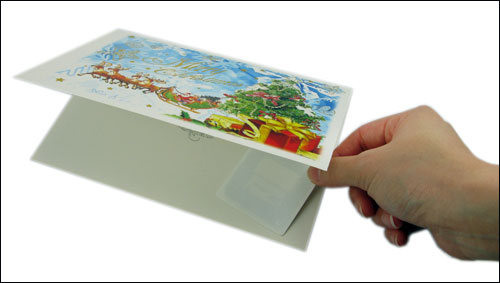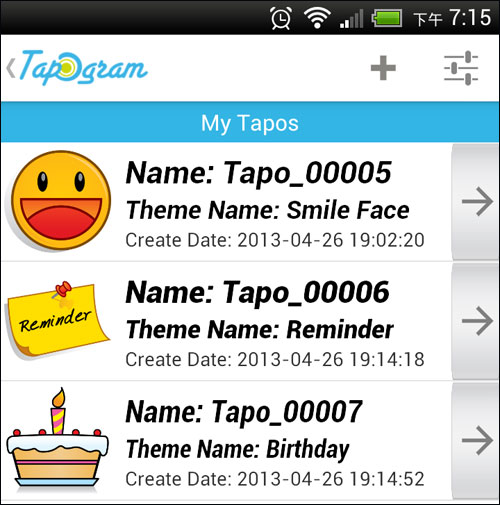RFID hardware manufacturer and distributor Hong Kong RFID Ltd. is marketing a Near Field Communication (NFC) mobile app to allow users of the technology to store and access audio recordings via an NFC RFID tag. The app is free to download, but Hong Kong RFID has also set up an online store at which visitors can purchase passive NFC RFID tags for use with the app, as well as NFC-enabled smartphones.
Users can simply download the Tapogram app (available for free at Google Play), and then install it on an Android smartphone and purchase NFC tags from Hong Kong RFID Ltd.’s NFC Shop online store, or at another venue. To record a message, a user taps the mobile phone against the tag and is prompted to begin recording a voice message (known as a “Tapo”) that can be up to 10 seconds in length. The app uploads the message to the Tapogram server, hosted by Hong Kong RFID. The user can then apply an RFID sticker to a gift or other item, or at a location such as a doorway. After the gift’s recipient downloads the app, the individual can then tap his or her NFC-enabled phone against the tag. The app transmits the tag’s ID number to the Tapogram server via the Internet, accesses the audio recording and plays it on that person’s phone.

According to Craig Jo, Hong Kong RFID Ltd.’s business development director, an audio recording—as opposed to a text or printed message—offers a more personalized or emotional experience. For example, he says, it would be more romantic to hear someone say “I love you” than to read a note containing those same words.
The Tapogram is a new focus for Hong Kong RFID, which has traditionally provided solutions for corporate clientele. “That was when NFC or RFID was not yet popular among general end consumers,” Jo explains. “Now that the smartphone market has driven more awareness to RFID and NFC, we saw a market space which we can explore and see if any business opportunity exists.” He adds, “It is much easier to promote RFID when everyone has a reader [an NFC-enabled phone] on hand.”
End users have been rapidly developing their own use cases for the solution, Jo reports. For example, for a gift, a user can record a personal message to the recipient, apply the tag to the gift and then direct the recipient to tap his or her phone against the tag in order to hear the message— such as “happy birthday”—in the sender’s own voice. It can also be used to record to-do lists that can be applied within a user’s home, indicating that he or she has completed a series of tasks. This function, Jo notes, can be provided to children when parents want to leave instructions for when they return home from school, such as “do your homework” or “water the plants.” The tag could also be applied to a dog’s collar, to verbally provide the animal’s name and the owner’s phone number. What’s more, it would work with a photo album, recording audio details to accompany pictures.
Upon creating a Tapo, a user can choose whether or not to share it with others. If unshared, the Tapo can be played only by the specific phone that launched the recording; otherwise, the recording is accessible by anyone equipped with an NFC reader and the Tapogram app.
Hong Kong RFID is currently marketing its Tapogram app and tags at its Tapogram Facebook page and its NFC Shop Web site. To boost sales, the company is offering a 20 percent discount on its tags to customers who “like” the Tapogram Facebook page and are directed to the NFC Shop site.
Users can purchase Hong Kong RFID Ltd.’s tags from the company’s NFC Shop site, but the Tapogram app also works with any other make and model of NFC-compliant RFID tag, such as those made with the following NXP Semiconductors RFID chips: Mifare Classic, DESFire, Ultralight and Ultralight C. Hong Kong RFID’s tags include stickers, key fobs, waterproof disks (such as laundry tokens) and on-metal stickers, and typically cost approximately $14 for 10 on-metal stickers, or $9 for 10 basic adhesive labels.

Lee says the solution is part of Hong Kong RFID’s efforts to provide an app to those with NFC phones who are not yet finding much functionality for their NFC-based technology.
Hong Kong RFID debuted the solution at the RFID Journal LIVE! 2013 conference and exhibition, held earlier this month in Orlando, Fla.
The app is currently available for free, Jo says, though at some point in the future, the company may opt to release an advanced version at a cost that will offer greater functionality. However, he says, details regarding such a product have not been determined.
The Tapogram may lead to other consumer offerings from Hong Kong RFID, Jo says. “Evaluating Tapogram’s performance,” he states, “certainly helps us in deciding whether more consumer-based solutions are feasible and profitable.”

